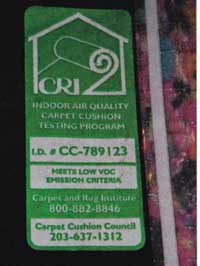AMAZON multi-meters discounts AMAZON oscilloscope discounts
It probably wouldn’t be possible to catalog every chemical, harmful or not, that we come in contact with through building products and furnishings. But among the most common are formaldehyde, which comes from a widely used adhesive called urea formaldehyde; vinyl chloride; plasticizers called phthalates; and a compound called styrene-butadiene latex that is found in carpeting. Many are produced in enormous quantities and find their way into a variety of products. We usually like what they can do for the products we use, but we won’t like their potential effects on our health.
Formaldehyde
One of the most widely used adhesives in the construction industry, urea formaldehyde is durable and inexpensive. It is very common in wood products made with particleboard such as cabinets, countertops, and shelving. The problem is that formaldehyde is also a potent eye, upper respiratory, and skin irritant. It off-gases from these products for years, leading to a number of potential health problems: wheezing, coughing, sneezing and skin irritation, depression, difficulty in sleeping, rashes, nausea, diarrhea, and chest and abdominal pain. Formaldehyde is known to cause cancer in animals and is a suspected human carcinogen.
A study at Ball State University suggests that low levels of formaldehyde commonly found in U.S homes are enough to trigger a variety of symptoms in concentrations as low as 0.09 parts per million, a level common in many U.S. homes.
Vinyl chloride
Vinyl chloride, the monomer from which polyvinyl chloride (PVC) is made, is also ubiquitous. Vinyl chloride is thought to be connected to a long list of serious health problems, including cancer and damage to the nervous, circulatory, and immune systems. It is now so widespread that it is found in polar bear fat. Vinyl chloride is not toxic when it is bonded into chains, such as PVC, but it is present as PVC is manufactured and often in its disposal, particularly when burned. One of the by-products in the manufacture of vinyl chloride is dioxin, a carcinogenic and persistent environmental chemical. (That means it doesn’t biodegrade.)
Vinyl chloride monomer is linked to a wide variety of health ailments, the most significant being liver cancer but also including central nervous system disorders and pulmonary abnormalities. It also has been linked to acroosteolysis, a syndrome affecting peripheral nerves in the hands and fingers, characterized by numbness, tingling, excessive sensitivity to cold and pain, and dissolution of the bones. In soft vinyl products some unbonded vinyl chloride molecules are volatile. That’s the characteristic smell of a new car, beach balls, and shower curtains. Our nose knows.
Phthalates
Petroleum-based chemicals added to plastics help make the material more useful. PVC additives include plasticizers such as phthalates that make our upholstery comfier and our pipes more flexible. Today, phthalates are one of the top offenders in a group of 70 suspected endocrine-disrupting chemicals (EDCs) that we use in our homes and yards. In January 2006, the European Union placed a ban on six types of phthalate softeners. When we’re done with these products, we dump them or burn them in our incinerators, where their runoff filters into our national waterways. Even if you eschew plasticized products in your personal lives, it’s impossible to avoid contamination; EDC5 are in the bodies of every man, woman, child, and fetus in the U.S.
To keep up with the world’s affection for all things plasticized, the U.S. produces a billion pounds of phthalates a year. The additive is used to make plastics more useful and more user-friendly.
A study in 2005 was the first to show a connection between phthalate exposure and incomplete genital development. It found that pregnant women with higher urine concentrations of some phthalates were more likely to give birth to sons with “phthalate syndrome”— incomplete male genital development, a disorder previously seen only in lab rats. Environmental exposure to EDCs is the suspected cause of declining male testosterone levels over the past two decades, as well as declining male birth rates in industrial areas such as Seveso, Italy, and the Dow Chemical Valley in Sarnia, Ontario.
Research has found that phthalates leach from vinyl flooring and are found in dust in homes and in wash water, raising a particular concern for children who naturally spend time on the floor.
Styrene-butadiene latex
Most of the carpeting sold for residential use includes a solvent-based adhesive and a binder that helps hold carpet fibers to the backing. The “new carpet odor” that people may notice after carpet is installed is usually 4-phenylcyclohexene (4-PCH), which is a by-product of the styrene-butadiene latex binder. This chemical has a very low odor threshold, which means it can be in the air at only trace levels and still be detected by the human nose.
Immuno-toxicologist and neuro-toxicologist Gunnar Heuser has found consistent, objective evidence of injury in patients exposed to new carpet. He wrote: “A full workup shows abnormalities that are consistent with other types of chemical injury, including an abnormal neuropsychiatric exam consistent with what is typically found in head injury patients, altered natural killer cell function, increased TA1 cells of the immune system, autoimmunity [meaning that the body immune system has mistakenly identified its own tissues or cellular components as foreign and directed antibodies against them] including auto-antibodies to thyroid, myelin of the nervous system, and anti nuclear antibodies.”
A Johns Hopkins University School of Hygiene and Public Health study supported the hypothesis that exposure to butadiene is associated with the risk of leukemia.

When buying carpet, look for a sticker from the Carpet and Rug Institute certifying that the product meets its standards for low-VOC emissions.
Prev.: Contaminants and their
Impact on Health
Next: The Cure for Dirty Air